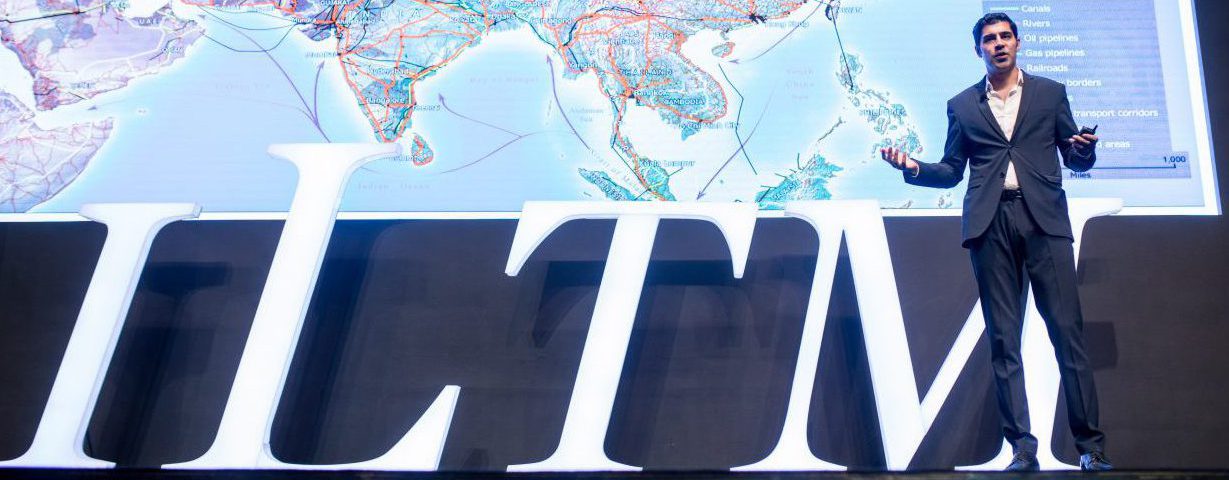Parag Khanna is a genius. Know anyone else who has spent the past 20 years travelling through Asia meticulously researching its connective infrastructures, transportation, energy, communications, and trade? … Anyone?
Not only is he the type of hardy traveller that puts most of us to shame (this year he embarks on a journey from Scotland to Singapore by train… with his 8 year old daughter!) he is also Senior Research Fellow at the Centre on Asia and Globalisation at the National University of Singapore, which means he’s the closest thing we’ve got to a crystal ball into the future of luxury tourism in Asia.
As part of ILTM’s #keeptheworldmoving series, here are some highlights from the interview we did when we met up with Parag at ILTM Asia 2017.
Parag on the ‘One Belt, One Road’ initiative and the impact of Chinese capital investment on global trade and tourism…
I have been writing about the precursors of One Belt One Road by travelling in Kazakhstan, Uzbekistan and Pakistan for the last 20 years. People only began to care about Chinese infrastructure in Asia exactly 8 weeks ago with the One Belt One Road Summit but this is my life, my career has been devoted to looking at this issue and now it’s becoming real. I want to make sure that everyone has that common baseline of what Asia linkages to the rest of the world are now, how beneficial they are, and what the next phase of those relationships is going to be like.
Let’s be absolutely clear, this is about the hard infrastructure, the supply chains, the connectivity, the smoothing of commerce, dealing with customs and border issues, harmonising investment regulation and getting construction projects done. There’s no reason for us to dance around the issue, you don’t get millions of tourists a year if you have no infrastructure. You probably know Hong Kong gets more tourists a year than all of India, right? And that’s not going to change until India has good roads and railways and highways. I’m an infrastructure determinist but I’m also am a huge believer in travel and tourism – the two go hand in hand but there’s a sequencing issue. Uzbekistan is a breath-taking country but it’s not going to get a lot of visitors until it has a convertible currency (they’ve just graduated from coupon vouchers). They have to go visa free, they have to go electronic with visas, and this is actually what One Belt, One Road is going to do – it’s going to put money into modernising these boring bureaucracies that are actually the facilitators, the conduits for facilitating tourism.
Chinese cities, even second tier Chinese cities have done such a good job of internationalising their flight connectivity, which means that you’ll get people from all over the country exploring new markets, and I know for a fact that those markets are working hard to prepare. Entire countries like Russia and Kazakhstan are saying, “What can we do better? How can we change our brand through tourism? How can we brand ourselves as the fresh water and clean air capital of the world?”. Everywhere along this broader Eurasian space is trying to attract not just Chinese but all Asian tourists. I’ve even seen it in Pakistan, it’s going to be a while before you have large-scale tourism, but every country does want it, just the mere presence – the dangling of the Belt and Road funds – is getting countries to snap into line. Countries that were really lazy about political reform, about investment regulation, about public safely, they’re saying, “Wow, there’s all this money on the table and we’re only going to get it if we clean up our act”. And that’s really what I see happening in every single country, one at a time, even places like Iran where I went last year. Everyone wants to be fundamentally recognised and honoured by the fact that wealthy Asians have decided to come to their country as opposed to just go to Paris – and that day is coming.
On the importance of Asia Pacific outbound tourism…
One thing that’s broadly underestimated is the importance of a certain critical set of industries to the world economy; infrastructure, construction and housing is one of them, tourism is another. As we know, the tourism and hospitality sector is one of the largest employment generators on the planet and one of the largest verticals of real GDP in the world – some say up to 10% or more global GDP comes from this industry! So it’s not largely appreciated.
There are 4 billion Asians and only 1.5 billion Chinese so let’s remember that the entire middle-class growth story of the world is not only China. Asia Pacific tourism is a huge driver of the changing nature of cultural relations and economic planning. You can see the countries that seasonally benefit from the high penetration and demand from Asian tourists, whether it’s the Maldives or whether it’s resorts in Europe and so forth. If you’ve been to the Maldives, they know exactly which islands the Chinese prefer and what style of resorts. India is the largest source of travellers to any number of countries in the Middle East, the UAE and so on, so yes, every country around the world is trying to factor Asians into their travel calculus.
On the geo-political tensions between China and its neighbours and the impact on inter-APAC travel…
(There have been a number of disputes in recent years including a partial ban on travel to Taiwan, a ban on travel to South Korea, the Thai island dispute that harmed relations with Japan, and an anti-Chinese riot it Vietnam)
Anyone who looks at the bilateral relationships between China and South Korea or China and Japan would not hesitate to predict they will normalise. There’s a sense that what’s happening now is definitely higher stakes than a couple of fishing boats ramming each other in 1994, but the counter-balancing forces are a lot stronger, the economies are a lot more integrated, there’s a lot more mutual benefit, there are major economic powers in terms of the companies involved in the integration, so the restraining forces are also a lot stronger than they were back in the days when you would go to war over chess pieces, we don’t really do that anymore. All of the fastest growing economic regions and sub regions of the world are in this hemisphere. The pillars of global growth, the pillars of world economic growth and world trade growth are all in Asia. If you’re a traveller fundamentally like me, you feel these things, you know them to be true and you amass the data that proves it.
On the future’s hottest destinations…
Uzbekistan is one of the most exotic countries on earth. The Silk Road monuments and treasures in Samarkand and Bukhara are unrivalled, maybe Iran comes close but Uzbekistan is truly just breath-taking and you can very easily imagine luxury trains there like the Orient Express, because there are luxury lines that can easily go on wards through Turkmenistan, Uzbekistan and Kazakhstan into China, so that extension could be done and it will attract visitors for sure. Asia is going to wake up to these places, without a doubt. Japanese and Indians actually know more about America than they know about each other, but fast-forward 20 to 30 years; don’t you think that’s going to change? Don’t you think Asia is going to matter more to Asians than just each of them thinking about their relationship to London and New York?
Parag Khanna is a leading global strategist, world traveller, and best-selling author. He is also the Managing Partner of Hybrid Reality, a boutique geo-strategic advisory firm, and an attendee of ILTM Asia Pacific, which takes place in Singapore, 21-24 May 2018


